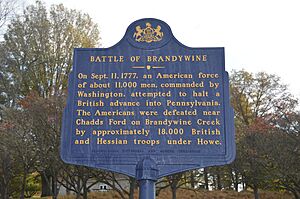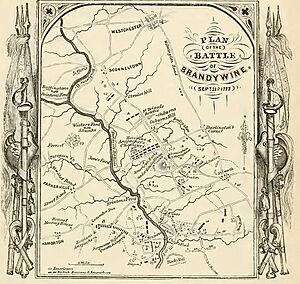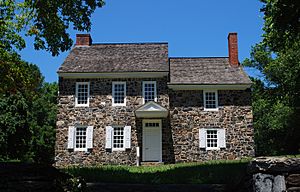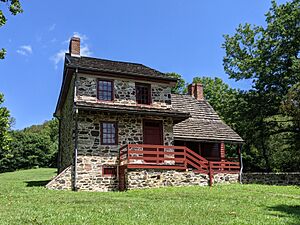Brandywine Battlefield facts for kids
|
Brandywine Battlefield
|
|
| Location | Delaware County, Pennsylvania, U.S. |
|---|---|
| Nearest city | Philadelphia, Pennsylvania |
| Area | 6,100 acres (2,500 ha) |
| NRHP reference No. | 66000660 |
Quick facts for kids Significant dates |
|
| Added to NRHP | October 15, 1966 |
| Designated NHLD | January 20, 1961 |
The Brandywine Battlefield Historic Site is a special place in Pennsylvania. It is a National Historic Landmark, which means it is very important to the history of the United States. This park is managed by the Pennsylvania Historical and Museum Commission. It covers about 52 acres near Chadds Ford.
This site was once part of the Battle of Brandywine. This big battle happened on September 11, 1777, during the American Revolution. It was a major win for the British army. Their victory opened a path straight to Philadelphia, which was the capital for the American rebels.
Brandywine Battlefield Park became a state park in Pennsylvania in 1949. It was named a National Historic Landmark in 1961. The actual battle covered a huge area, over 35,000 acres. But the park today focuses on the 50 acres where the American army camped before the battle. Another part of the battlefield is kept by Birmingham Township, Chester County, Pennsylvania. It is called "Battlefield of the Brandywine Park."
In August 2009, the state temporarily closed the battlefield due to money problems. But it reopened just 11 days later! Now, a group called "Friends of Brandywine Battlefield" helps run the site. They work with staff and volunteers to keep it open for visitors.
Contents
Why Brandywine Was Important
Brandywine Battlefield Park is in southeastern Pennsylvania. It is about half a mile east of Brandywine Creek. The park is also only about 30 miles from Philadelphia. This closeness to the city made it a key spot for a major battle.
The Brandywine Creek itself was a big obstacle for armies in the 1770s. It acted like a "moat" that blocked the British army. This "moat" kept them from reaching the Schuylkill River and the Continental Congress in Philadelphia. The British wanted to take control of Philadelphia. They hoped this would force the Congress out and end the war. The area was also a crossroads for the Thirteen Colonies. Controlling these roads was vital for getting supplies to both the British and American armies.
The Battle of Brandywine
In September 1777, General George Washington moved his American troops to Chadds Ford. He wanted to control the high ground there. His goal was to stop the British army, led by General Howe, from taking Philadelphia. Washington also wanted to avoid being trapped between the British army on land and the Royal Navy on the Delaware River. The British had landed in Maryland and were marching towards Philadelphia.
The British gathered their forces at nearby Kennett Square. General Howe did not plan a direct attack on Washington's strong defenses. Instead, he used a clever trick called a flanking maneuver. This was similar to what he did at the Battle of Long Island. About 5,000 British soldiers, led by Wilhelm von Knyphausen, marched to meet Washington's troops at Chadds Ford. Meanwhile, the rest of the army, led by Lord Charles Cornwallis, marched north. They went to Jefferis' Ford, a crossing Washington had missed. From there, they marched south to attack the American forces from the side.
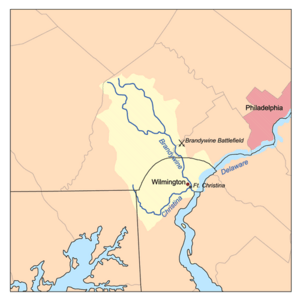
September 11 started with a thick fog. This fog helped hide the British troops as they moved. Washington received confusing reports about where the British were. He kept thinking the main attack would be at Chadds Ford. But around 2 p.m., the British appeared on the Americans' right side. General John Sullivan tried to move his troops to face this unexpected threat. But Howe was slow to attack, which gave the Americans time. They managed to position some of their men on high ground at Birmingham Meeting House. This spot was about a mile north of Chadds Ford.
By 4 p.m., the British attacked and quickly took the ground from the American army. Sullivan then attacked a group of Hessian soldiers. These Hessians were trying to get around the Americans near Meeting House Hill. This action bought more time for most of the American soldiers to retreat. But Sullivan's men were hit hard by British fire, forcing them to fall back.
At this point, Washington and Greene arrived with more soldiers. They tried to hold off the British, who now controlled Meeting House Hill. The remaining American soldiers held off the British for almost an hour. But they were eventually forced to retreat. The Americans also had to leave most of their cannon behind. This was because most of the artillery horses had been killed.
Meanwhile, Knyphausen attacked the weakened American center at Chadds Ford. He broke through and forced Wayne's division to retreat. Wayne also had to leave most of his cannon. Armstrong's militia, who had not even fought, also decided to retreat. Further north, Greene sent Colonel Weedon's troops to cover a road near Dilworth. They held off the British long enough for the rest of the American army to retreat. Darkness stopped the British chase. This allowed Weedon's force to retreat safely. The defeated Americans had to retreat to Chester. Most arrived at midnight, with others coming in until morning.
The battle was costly for both sides. The British lost about 89 soldiers killed and 487 wounded. They claimed to have killed 200 American soldiers, wounded 750 more, and captured over 400. They also destroyed or captured 11 American cannons.
Even though Howe won the battle, the strong American resistance stopped him from completely destroying their army. The American soldiers' spirits were not broken. Despite losing, they felt hopeful about fighting the British again. Neither commander showed their best skills in this battle. Washington made a big mistake by leaving his right side open. This almost led to disaster. But Sullivan, Sterling, and Stephen's divisions fought bravely and bought time. Howe waited too long to attack the American right side. This showed he was still afraid of losing too many soldiers, like at the Battle of Bunker Hill. Because of this, most of the American army escaped.
For the next few days, British and American forces moved around each other. There were only small fights, like the Paoli Massacre on the night of September 20–21.
The Continental Congress left Philadelphia. They first went to Lancaster, Pennsylvania for a day, then to York, Pennsylvania. Military supplies were moved out of Philadelphia to the Van Leer Furnace in Reading, Pennsylvania. This happened during Washington's retreat. On September 26, 1777, British forces marched into Philadelphia without anyone stopping them.
Visiting the Park Today
Before the battle, Brandywine Battlefield Park was a busy farming community. Quaker farmers were getting ready to harvest their crops. They were also planting winter wheat, preparing their animals, and selling young horses. These peaceful Quakers suddenly found themselves in the middle of a battle. Much of their farmland, animals, and crops were destroyed.
American officers took over their farmhouses before the battle. After the British won, their officers then occupied the Quaker homes. These homes have been fixed up to look like they did in 1777. Visitors can explore them today. The Benjamin Ring House is thought to have been used as headquarters by George Washington before the battle. Inside, you can see Quaker-style furniture and learn about the battle and Washington's time there.
The Gideon Gilpin House was once home to a wealthy Quaker farmer. It served as a place for the Marquis de Lafayette before the battle. He was brought back there after he was wounded. The British army took many things from this house after the battle.
People who dress up as historical figures, called reenactors, often visit the park. They portray Hessian soldiers, Quaker farmers, and British and American soldiers. They do this during special events throughout the year. Park staff and volunteers offer daily guided tours of the park and battlefield. They also lead hands-on activities, give talks, and host open houses. Most of the battlefield is protected. However, new buildings and towns growing nearby are a threat to the park. The park is protected because it is a National Historic Landmark District. The United States Congress gave it this special status in 1997.
Preserving the Battlefield
The Gideon Gilpin House has been carefully restored to look like it did in 1777. The Benjamin Ring House, used by General George Washington, was used until the 1930s. Sadly, young people accidentally caused a fire that destroyed it. In the 1950s, a new home was built to look like the original 1770s house.
The American Battlefield Trust and its partners have worked hard to save parts of the battlefield. By mid-2023, they had bought and protected over 187 acres of the battlefield.
See also




